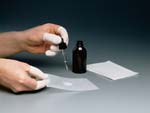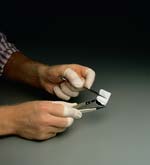Proper care and cleaning of optical components will assure optimum performance and maximum lifetime. Contaminants on an optical surface increase scatter off the surface and absorb laser energy, creating hot spots that eventually lead to coating failure.
Cleaning of any precision optic risks damaging the surface, so optics should only be cleaned when necessary. The need for cleaning can be minimized by returning optics to their case or covering the optic and mount with a protective bag when not in use. When cleaning is required, we recommend this equipment list and one of the following procedures.
Cleaning Supplies
• Latex Finger Cots and Gloves: Solvents are harsh to the skin, wear protection.
• Optics Cleaning Tissue: Soft, absorbent, lint-free lens tissue is best.
• Swabs: Cotton swabs with wooden handles or polyester swabs with polypropylene handles are best.
• Blower: Filtered dry nitrogen blown through an anti-static nozzle is best. Canned dusters also work. Bulb-type blowers and brushes must be kept clean to prevent re-contamination.
• Mild Soap: Neutral soap, 1% in water. Avoid perfumed, alkali, or colored soaps. Several drops of green soap (available at a pharmacy) per 100 cc of distilled water is acceptable.
• Isopropyl Alcohol: Spectroscopic grade, evaporates more slowly than acetone.
• Acetone: Spectroscopic grade.
• Hemostat: For holding lens tissue.
• Tweezers: For holding small optics.
• Bright Light: For inspection.
Dust Cleaning
Dust on optics can be very tightly bound by static electricity. Blowing removes some dirt; the remainder can be collected by the surface tension of a wet alcohol swab. Acetone helps promote rapid drying of the optic to eliminate streaks.
Blow off dust. If any dust remains, twist lens tissue around a swab, soak in alcohol, and wipe the optic in one direction with a gentle figure-eight motion. Repeat as necessary. Next, repeat using acetone.
Cleaning Heavy Contamination
Fingerprints, oil, or water spots should be cleaned immediately. Skin acids attack coatings and glass and can leave permanent stains. Cleaning with solvents alone tends to redistribute grime. These contaminants must be lifted from an optical surface with soap or other wetting agent. The optic is then rinsed in water and the water removed with alcohol. Acetone helps speed drying and eliminate streaks.
Blow off dust. Using a soap saturated lens tissue around a swab, wipe the optic gently in a figure-eight motion. Repeat as necessary. Repeat this procedure with distilled water. Repeat again with alcohol. Repeat once more with acetone.
Drop and Drag Cleaning Method
This method is often used for light cleaning of flat optical surfaces, such as mirrors. For cleaning grease, oil, water spots, or other heavy contamination, first use the cleaning procedure described above.
Place the optic on a clean work surface. Blow off dust. Hold a piece of unfolded lens tissue above the optic and place a few drops of acetone on the tissue. Lower the lens tissue onto the optic and pull it across the optic. Repeat this procedure until the optic is clean. Be sure to use a new piece of lens tissue with each pass. This will avoid scratching the optical surface by dragging loose contaminants.
Brush Cleaning Method
This technique is ideal for cleaning smaller optics, including lenses, and involves holding a folded lens tissue with a hemostat to brush the surface clean.
Fold a lens tissue so as not to touch the part of the tissue that will make contact with the optic. The fold should be about as wide as the optic. Hold the tissue with hemostats parallel to and near the fold. While holding the optic, using tweezers if necessary, blow off any dust. Soak the tissue with acetone. Brush the fold in the tissue across the surface of the optic using light pressure. Repeat as necessary until the optic is clean, making sure new lens tissue is used for each wipe.
For mounted optics with hard-to-reach edge corners, wrap lens tissue around a swab, soak it in acetone, brush around the edge and then across the middle using a continuous figure-eight stroke. Repeat if necessary.
Wipe Cleaning Method
This technique is used to thoroughly clean lenses and mirrors, this method involves wiping an optic with a lens tissue by hand. Blow off dust. Fold a lens tissue as with the brush method. Apply acetone to the tissue. Holding the lens tissue in your hand with the fold near the tip of your fingers, apply uniform pressure while gently wiping across the surface of the optic. Repeat as necessary until the optic is clean, making sure new lens tissue is used for each wipe.
Immersion Cleaning Method
Delicate optics with soft coatings such as bare metallic mirror coatings are most safely cleaned by immersion. Do not immerse cemented optics.
Blow off dust. Prepare four petri dishes filled with soap solution, distilled water, alcohol, and acetone. Line the bottom of each with lens tissue to prevent damaging the optic. Immerse the optic in soap solution. Gently agitate. Immerse in distilled water. Agitate. Immerse in alcohol. Agitate. Finally, immerse in acetone. Agitate. Blow dry. Repeat these steps using new washing solutions to prevent recontamination until the optic is clean.



